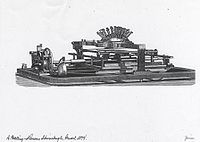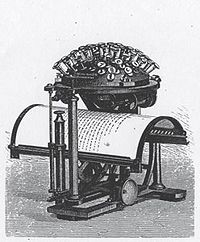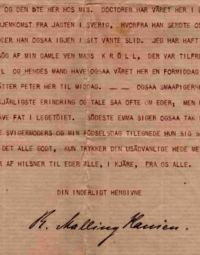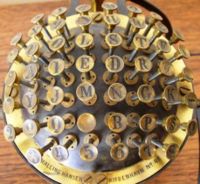
Hansen Writing Ball
Encyclopedia






Rasmus Malling-Hansen
Rasmus Malling-Hansen was a Danish inventor, minister and principal at the Royal Institute for the Deaf, and one of the true pioneers of the 19th century. He possessed a great urge to bring forward new ideas and new inventions, and to reveal the secrets of unknown connections in nature...
, 1835-1890. The writing ball was first patented and entered production in 1870, and was the first commercially produced typewriter. In Danish it was called the skrivekugle. The Hansen ball was a combination of unusual design and ergonomic innovations, but like most of the early 19th century typewriters, it did not allow the paper to be seen as it passed through the device.
Overview
Its distinctive feature was an arrangement of 52 keys on a large brass hemisphere, causing the machine to resemble an oversized pin cushion. From the book Hvem er Skrivekuglens Opfinder, written by Malling-Hansen's daughter Johanne AgerskovJohanne Agerskov
Johanne Elisabeth Agerskov , daughter of the Danish inventor Rasmus Malling-Hansen, was a Danish intermediary. Together with her husband, Michael Agerskov, she was responsible for the ethic-religious, philosophic and scientific book, Toward the Light , first published by Michael Agerskov in...
, we know how Malling-Hansen made experiments with a model of his writing ball made out of porcelain. He tried out different placements of the letters on the keys, to work out the placement that led to the quickest writing speed. He ended up placing the most frequently used letters to be touched by the fastest writing fingers, and also placed most of the vowels to the left and the consonants to the right. This, together with the short pistons which went directly through the ball, made the writing speed of the writing ball very fast.
The first models typed on a paper attached to a cylinder, and included an electromagnetic escapement for the Ball, thus making Malling-Hansen's machine the first electric typewriter. He made several improvements on his invention throughout the 1870's and -80's, and in 1874 he patented the next model, and now the cylinder was replaced by a flat mechanical paper-frame. The electromagnetic battery was still used to move the paper along as the Ball typed upon it, and the design led to a lower possibility for error. Malling-Hansen improved further on his design, and created a semi-cylindrical frame to hold one sheet of paper. This best known model was first patented in 1875, and now the battery was replaced by a mechanical escapement. All these improvements made for a simpler and more compact writing apparatus.
It was exhibited at a great industrial exhibition in Copenhagen in 1873, at the world exhibition in Vienna in 1873, and at the Paris exhibition or Exposition Universelle
Exposition Universelle (1878)
The third Paris World's Fair, called an Exposition Universelle in French, was held from 1 May through to 10 November 1878. It celebrated the recovery of France after the 1870 Franco-Prussian War.-Construction:...
. All through the 1870s it won several awards.
The writing ball was sold in many countries in Europe, and it is known that it was still in use in offices in London as late as 1909. But due to its hand-crafted production, it was overtaken in the market by the mass produced Sholes-Glidden machine which E. Remington and Sons
E. Remington and Sons
E. Remington and Sons was a manufacturer of firearms and typewriters. Founded in 1816 by Eliphalet Remington in Ilion, New York, on March 1, 1873 it started manufacturing the first commercial typewriter.-Becoming "E. Remington & Sons":...
started to make in 1873.
Malling-Hansen also invented a very high speed writing machine for stenography
Shorthand
Shorthand is an abbreviated symbolic writing method that increases speed or brevity of writing as compared to a normal method of writing a language. The process of writing in shorthand is called stenography, from the Greek stenos and graphē or graphie...
, called the Takygraf, and a copying technique called the Xerografi- both invented in 1872.
More-or-less intact Hansen balls have fetched hundreds of thousands of Euro
Euro
The euro is the official currency of the eurozone: 17 of the 27 member states of the European Union. It is also the currency used by the Institutions of the European Union. The eurozone consists of Austria, Belgium, Cyprus, Estonia, Finland, France, Germany, Greece, Ireland, Italy, Luxembourg,...
s in auctions. Few remain in existence today.
Nietzsche's Hansen Writing Ball
In 1881, when he had serious problems with his sight, Nietzsche wanted to buy a typewriterTypewriter
A typewriter is a mechanical or electromechanical device with keys that, when pressed, cause characters to be printed on a medium, usually paper. Typically one character is printed per keypress, and the machine prints the characters by making ink impressions of type elements similar to the pieces...
to enable him to continue his writing, and from letters to his sister
Elisabeth Förster-Nietzsche
Therese Elisabeth Alexandra Förster-Nietzsche , who went by her second name, was the sister of philosopher Friedrich Nietzsche and the creator of the Nietzsche Archive in 1894....
it is known that he personally was in contact with “the inventor of the typewriter, Mr Malling-Hansen from Copenhagen”. He mentioned to his sister that he had received letters and also a typewritten postcard as an example.
Nietzsche received his writing ball in 1882 directly from the inventor in Copenhagen
Copenhagen
Copenhagen is the capital and largest city of Denmark, with an urban population of 1,199,224 and a metropolitan population of 1,930,260 . With the completion of the transnational Øresund Bridge in 2000, Copenhagen has become the centre of the increasingly integrating Øresund Region...
, Denmark
Denmark
Denmark is a Scandinavian country in Northern Europe. The countries of Denmark and Greenland, as well as the Faroe Islands, constitute the Kingdom of Denmark . It is the southernmost of the Nordic countries, southwest of Sweden and south of Norway, and bordered to the south by Germany. Denmark...
, Rasmus Malling-Hansen
Rasmus Malling-Hansen
Rasmus Malling-Hansen was a Danish inventor, minister and principal at the Royal Institute for the Deaf, and one of the true pioneers of the 19th century. He possessed a great urge to bring forward new ideas and new inventions, and to reveal the secrets of unknown connections in nature...
. It was the newest model, the portable tall one with a color ribbon, serial number 125, and several typescripts are known to have been written by him on this writing ball (approximately 60). It is known that Nietzsche was also familiar with the newest model from E. Remington and Sons
E. Remington and Sons
E. Remington and Sons was a manufacturer of firearms and typewriters. Founded in 1816 by Eliphalet Remington in Ilion, New York, on March 1, 1873 it started manufacturing the first commercial typewriter.-Becoming "E. Remington & Sons":...
(model 2), but he wanted to buy a portable typewriter so he chose to buy the Malling-Hansen writing ball, as this model was lightweight and easy to carry.
Unfortunately Nietzsche wasn't totally satisfied with his purchase and never really mastered the use of the instrument. A number of theories have been advanced to explain why Nietzsche did not make more use of it. New research indicates Nietzsche was not aware that his trouble in using the machine had been caused by damage to it during transportation to Genoa in Italy, where he lived at the time. And when he turned to a mechanic who had no typewriter repair skills, the man managed to damage the writing ball even more. Nietzsche claimed that his thoughts were influenced by his use of a typewriter ("Our writing instruments contribute to our thoughts", 1882). As one researcher has noted, "Nietzsche's interest in rhetoric and his experience of the typewriter framed his understanding of language in a highly symbolic way: the traditions of the philosophy of language versus the scientific and technological conditions of knowledge." On February 16, 1882 he even made a poem about his writing ball:
Schreibkugel ist ein Ding gleich mir: von Eisen
Und doch leicht zu verdrehn zumal auf Reisen.
Geduld und Takt muss reichlich man besitzen
Und feine Fingerchen, uns zu benuetzen.
Or in English:
The Writing Ball is a thing just like me: of iron
And yet easy to twist, especially on journeys.
Patience and tact one must richly possess
And fine little fingers to use us.

